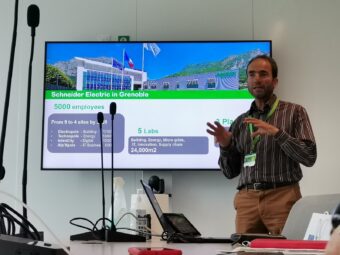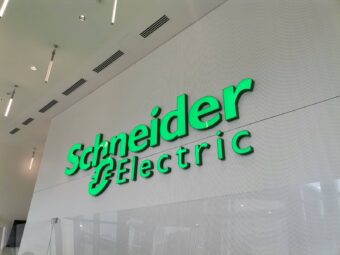
IntenCity is Schneider Electric’s new flagship building in Grenoble, France’s Scientific Polygon (Presqu’île). This year is special for Grenoble since the city has been named the 2022 European Green Capital. The award highlights Grenoble’s long-term commitments to sustainable development.
As a leading expert in sustainability and decarbonization, Schneider Electric’s newest building IntenCity, with its 26,000 m², illustrates their vision of Buildings of the Future which they believe needs to be sustainable, resilient, and hyper-efficient, and people-focused. It is part of a big project reorganizing Schneider Electric’s facilities in Grenoble, where 135M€ have been invested over five years to deploy their workplace policy in all their sites and showcase their energy management solutions. The objective was to regroup 5,000 workers from over 13 different sites into four major buildings (Technopole, Alp’Xpôle, Electropole, and IntenCity). The company aimed to reduce the group’s carbon footprint by choosing environmentally friendly buildings, reducing inter-site travel, strengthening cross-department team collaboration, and public and private sector organizations in Grenoble area such as R&D, Universities and laboratories.
We talked with Mr Pascal Bonnefoi, in charge of the customer visits in Grenoble for Schneider Electric. He explained that the key features of the new generation of buildings are energy efficiency and the capability of compensating their consumption with local production. Contrary to the company’s other facilities in the region, which are renovated buildings, IntenCity was built from scratch with two objectives, the human objective to reduce the number of sites and maximize the exchange between the employees and also to be a demonstrator of Schneider Electric’s building solutions.
IntenCity has its own Building Information Modeling (BIM), which is an exact reflection of the construction and an energy model capable of reproducing the energy behavior of the real building. Schneider Electric is the first group in the world to use a 3D visualization model for real-time building monitoring. They created an animation with the 3D lenses for the employees two years before the delivery of IntenCity, to encourage the change management and allow the people to visit the place and better understand the environment.
More:
Efficient building
Equipped with EcoStruxure™ Building solutions, Intencity consumes only 37 kWh per m2 per year, just 10 percent of the average consumption of buildings in Europe with 348 kWh per m2 per year.
IntenCity began efforts to obtain the LEED Platinum certification from the very beginning. It is the highest level of the Leadership in Energy and Environmental Design certificate. The building is aiming for a score of 103 credits (out of a maximum of 110), making it the most energy-efficient in the world. Mr. Bonnefoi mentioned that there are still some technical issues they need to work towards solving, such as the problem with the quality of the underground water, which results in the occasional malfunction of the filters used in the geothermal power.
Building’s efficiency is also shown through real-time energy consumption. Thanks to the command-control which enables the “energy-saving” mode to be activated on a floor or area that is not being used and thus avoids unnecessary consumption. Building’s efficiency is also shown through facility management, thanks to monitoring tools that collect information (temperature, luminosity, CO2 levels, occupancy, etc.). The building captures over 60,000 data points every 10 minutes, with sensors automatically reducing energy in unoccupied spaces.

Mr Bonnefoi said “automatization in IntenCity is a constant equilibrium between the efficiency from the software system and the comfort of the people”.
Flexible Building
The site generates over 920 MWh of energy per year (enough to power 200 homes) using 4,000 square meters of photovoltaic panels fitted to the roof, two vertical wind turbines, geothermal power from the underground water and 300kW on-site energy storage, thus making the building energy autonomous.
Smart district contribution
Through a unique microgrid partnership, energy is also shared with neighboring buildings and the city of Grenoble. As a smart grid-ready building, IntenCity can opt-out in the event of high demand for electricity or a high tariff, storing the renewable energy produced and deferring consumption in favor of neighboring buildings.
Working towards its goal to become net carbon zero by 2030, Schneider Electric confirms its commitment to reducing greenhouse gas emissions in line with Grenoble’s Air Energy Climate Plan.
In Schneider Electric, they believe the performance of your buildings significantly impacts the productivity of your people, the success of your business, and the health of the planet.
“In our EcoStruxure building solution in Schneider, we have implemented a solution from a partner company Saint-Gobain who manufactures glass that is sensible to electricity. If you apply an electrical current, you can shade the windows which allows us to optimize energy by shading the windows in summer to reduce the incoming energy and making them transparent in winter to maximize the incoming energy. It’s an evolution of the solution of our partner. Initially the Saint-Gobain’s offer was the visual comfort only, thanks to EcoStruxure building solution we can use the same components for energy optimization. That’s really the value of Schneider electric, to offer a global solution and for our partner of course it’s a win win because the Saint-Gobain solution is now potentially offering a new solution not only for visual comfort but also for energy efficiency.
Katarina Potulić



